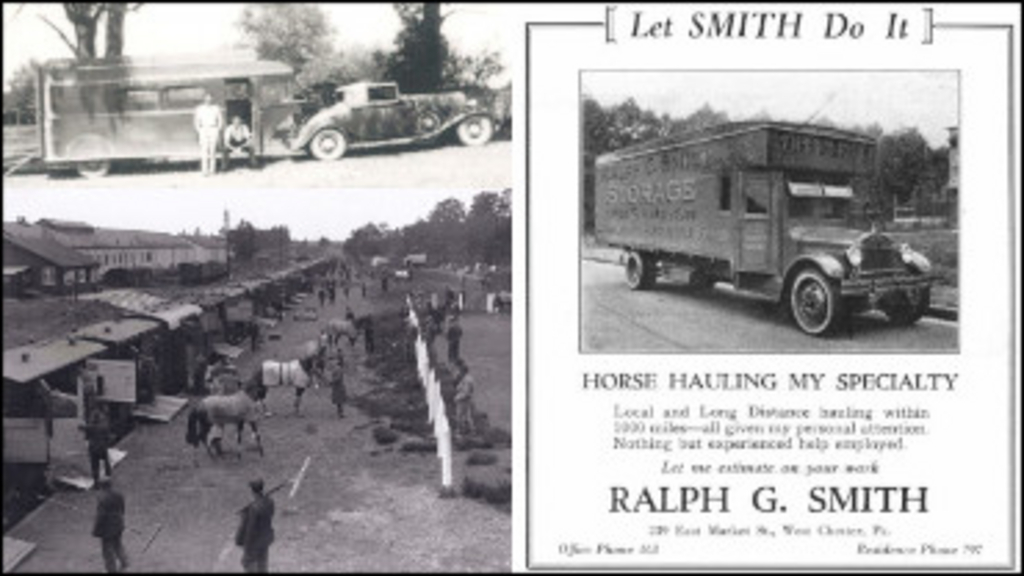
In this week's Rewind, Robert Smith turns the clock back many years and discusses the evolution of horse hauling vehicles and modes of transporting horses. He has also included a number of old photos of vehicles from days gone by. This is the second and concluding edition of a two-part story.
Today's Rewind is again about horse hauling vehicles but with more emphasis on commercial vehicles including movement by railcar and later truck transport.
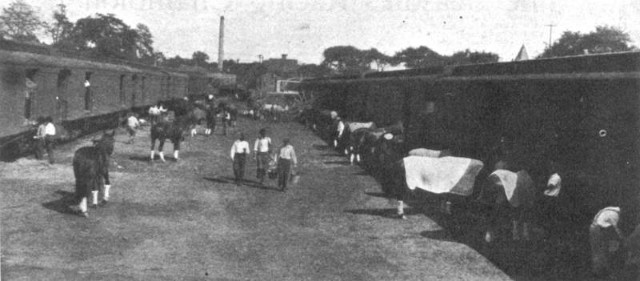
Horses shown getting ready for rail shipment in the early days.
For many years horses were moved about by means of rail cars and even by steamship. This was a difficult and sometimes cumbersome way of transporting horses as well as being time consuming but it was the best means available. Handlers frequently rode on the rail cars with the horses and that of course was quite an experience. I recall talking to the late Mervin Kirkness about his experiences riding the rails with horses and equipment all the way from Manitoba to tracks in Quebec. He said that the grooms had mattresses in place but seldom had a smooth enough ride to ever use them.

An old time scene showing horses being staged for rail shipment. These vehicles were quite small and compact and each one included a loading ramp which was an improvement from the very early versions. (Photo courtesy of Museum Of The Horse)
In researching for this story I read another story about the railcar days and how difficult it was to get food while travelling long distances with infrequent stops. The following passage was written by Ken McCarr in the Harness Horsemagazine in a 1971 article.
"The inability to get to restaurants during the freight rides caused some of the grooms to be resourceful. On one instant there is a remembrance of a groom jumping out of the door with a handful of straw. He lit it and then reached in for a frying pan in which he had broken two eggs. This was just a whistle stop so he had to work in a hurry and he held the frying pan over the fire until the train started and then ran for his car with his eggs, which were ready to eat."
The following is an excerpt from an article published in Jan. 1978 in Hoof Beats authored by Joe Goldstein:
The Grand Circuit got underway in 1873 and at this time the race horses were still most often driven from race point to race point. Only a few horses, belonging to the very wealthy, were shipped then by rail. Shortly afterwards, when railroad shipment had become thoroughly organized and rates reduced, a Master of Transportation was appointed by the Grand Circuit Stewards, whose duty it was to superintend the shipments, sometimes by special train, "along the line," throughout the season.
The advent of the motor truck ended this, as its greater flexibility as a vehicle, together with the fact that no precise timetables were necessary, made its use preferable. The first shipment of harness horses by truck is believed to have been made in 1910 for a short run in Ohio. Now our racing stock is trucked — or vanned — from ocean to ocean and air-transport has been introduced.
However, all but the longest journeys are now made by motor van or the "possum bellies" as the horsemen call the cavernous trailers which haul their race horses. The horse trailer has the obvious superiority in convenience and accessibility to sales, racetracks, and training centers. It also has been a safer form of transportation than rail. In the early days of railroading many accidents occurred in which the careers of some of the best horses in training were ended. This was the fate of Lady Thorn (2:18 1/4) when she was the "Queen of the Turf" in 1870. Lack of reasonable sanitation facilities on freight and express cars also cost the lives of many through the contraction of contagious diseases. Among these victims was Hamburg Belle (2:01 1/4).
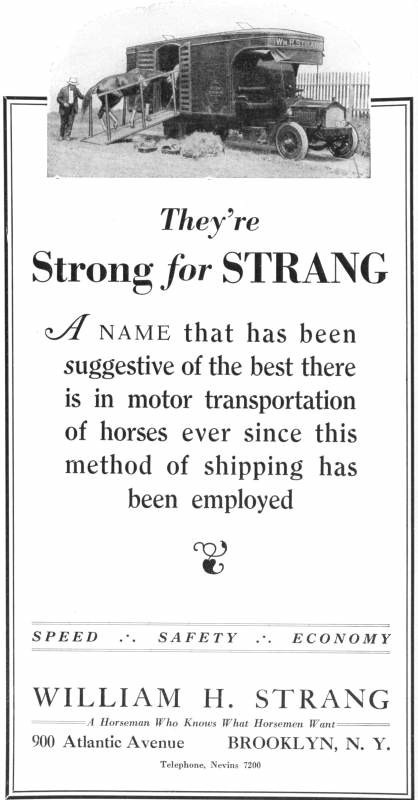
An ad for Strang Transport operating out of Brooklyn, N.Y. This gentleman who owned standardbreds was believed to be among the first people to offer commercial hauling of horses
It is not known for sure who developed the first horse van. Bill Strang, the late Brooklyn horseman, who owned the first Hambletonian winner, Guy McKinney and the 1951 Kentucky Futurity winner Ford Hanover, believes he was the originator of the motor van for horses. Strang was in the furniture business in Brooklyn and he recalls utilizing a furniture van, by the addition of stalls, for transporting horses before anyone else.
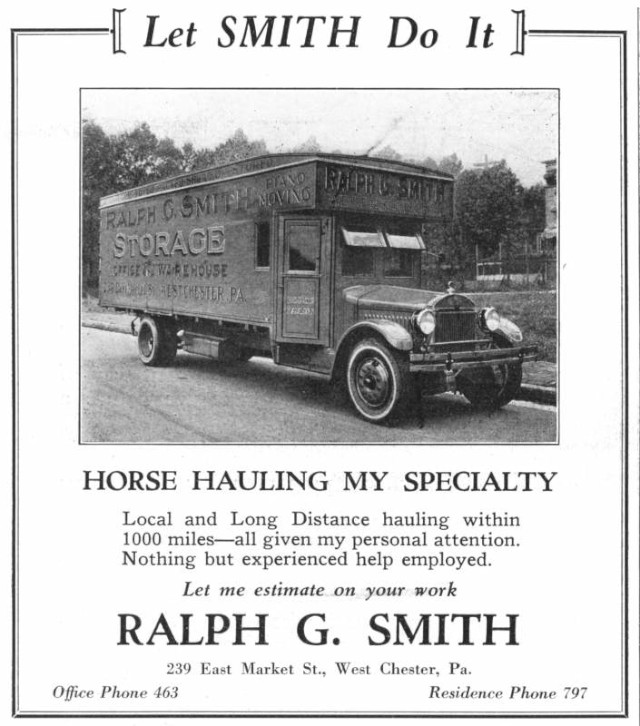
The above ad dates back to the early days of horse transportation. Was there always someone named "Smith" who got involved in just about everything?
A Great Picture And Story
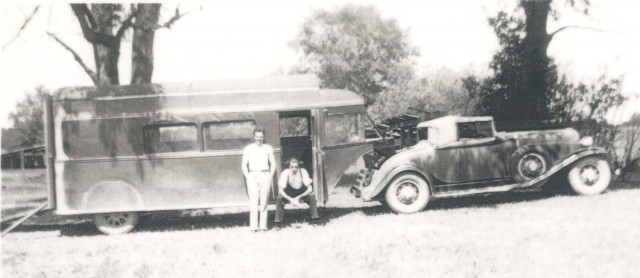
The above photo was taken during Grand Circuit Week in 1934 at Thorncliffe Park in Toronto. This was a huge event for Canadian harness racing. Many U.S. Stables shipped in for the meeting, mainly by rail. A smaller number of Canadian horses competed as well, most traveled by truck or trailer. The unit shown above belonged to Dr. W.N. Meldrum a medical doctor from Norwich, Ont. At that time the Meldrum stable included a number of top performing individuals topped by Dillon Mc and Sir Esme, both U.S. bred and brought to Canada.
On the left is Norman Meldrum, head trainer for his father's outfit and on the right is "Mose" Farrell, a barber from Norwich. Legend has it that times were extremely tough and barbering in Norwich was not a lucrative occupation at that time so Mr. Farrell headed to Toronto for the week and ended up cutting many heads for the princely sum of 10 cents each, considering himself very fortunate. While the trailer was used for transporting the horses, once on site it was swept and hosed out and converted to living quarters for members of the Meldrum contingent. I am not an old car buff but I would love to know what kind of car that is in the picture.
I am indebted to Leon Siple who supplied this picture from his father's collection and also for telling me the story.
Modern Day Vehicles
In the two Rewinds dedicated to looking at the evolution of horse hauling vehicles, photographs of the progress made in the last 100+ years has been in evidence. Below I will show what might be considered a few very modern vehicles. I would like to thank Pat at Doyle Transport located in Dundas Ontario for supplying these great photos.
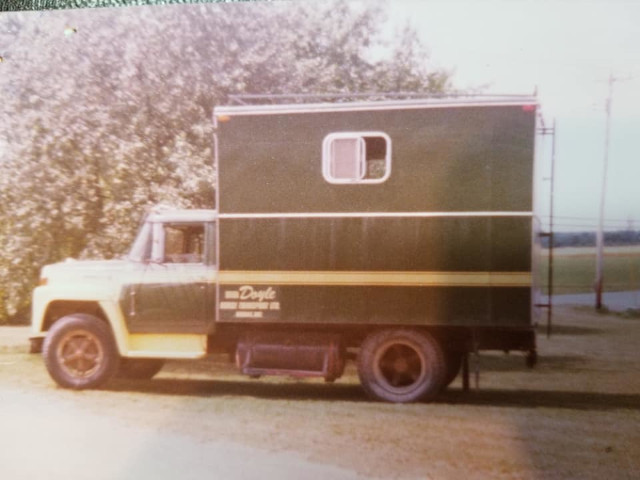
Here is an early vehicle from the fleet of Doyle Transport (Courtesy of Doyle Transport)
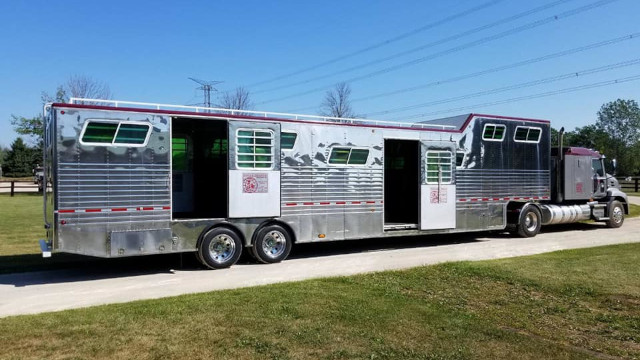
This streamlined rig is owned and operated by Doyle Transport of Dundas Ont. and contains just about all of the "bells and whistles" available in the latest horse hauling vehicles (Courtesy of Doyle Transport)
Quote For The Week: "Worry is the dark room where negatives develop."
Who Is It?

Can you name this well-known horseman? I can almost smell that stogie!
Whose horse truck is it?
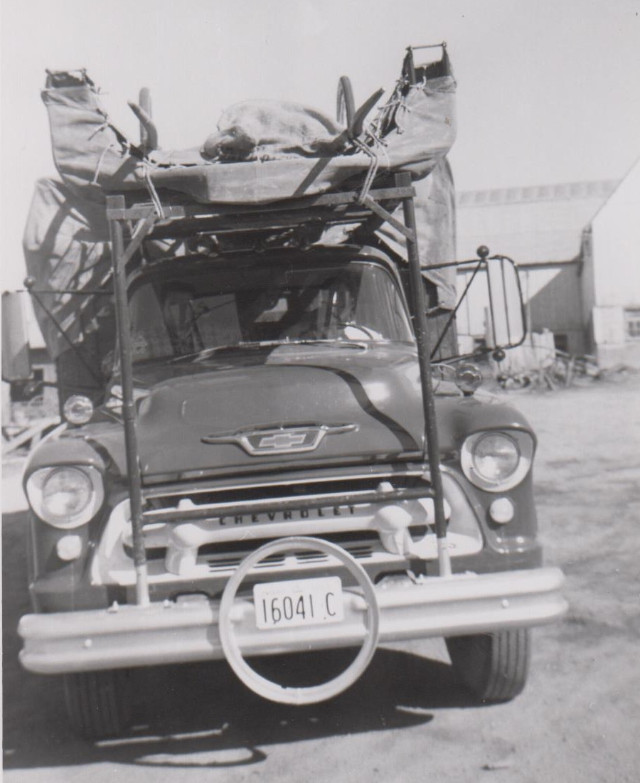
Can you identify this horse truck that was used for many years by a well-known harness racing family in Ontario? Photo taken in 1958. Members of this family are still hauling horses but have undoubtedly replaced this vehicle.


This week's photo quiz
This week's photo quiz pictures were as follows:
Man with the stogie was Chuck Sylvester a native of Ohio who has trained so many great horses including Mack Lobell that it would be difficult to list them all. For starters he has trained no less than three Hambletonian winners.
The horse truck belonged to Clifford Hie of Cobourg, Ontario. I have heard that he liked to drive a Chevrolet which makes him "a man after my own heart". I noticed that the pictured truck had fender mounted signal lights which possibly meant that they were retrofitted when they became law in the mid to late 50's. The early signal lights were not self-cancelling and people were forever driving down the road with signals flashing long after they had made a turn. Thanks to James Milne for your well wishes.
Thanks to everyone for your input.
Whose horse truck is it is
Whose horse truck is it is Cliff Hie’s from Cobourg, Ontario. Cliff had a cattle trucking business. He had two Chevy 3 ton trucks. He trucked cattle to Toronto Monday Tuesday Wednesday and pigs on Thursday. Then Friday and Saturday he trucked his horses to race at the fairs. If he was racing to the west it could be Port Hope, Orono, Oshawa, Brooklyn, Blackstock or Port Perry. To the North it could be Lindsay, Peterborough, Roseneath, Norwood, Lakefield, Warkworth or Campellford. To the east it was probably Colborne, Brighton, Belleville, Picton, Napanee, Stirling or Kingston or he could just stay at home and race at Grasshopper Flats. The picture of this truck is loaded with a jog cart and race bike. My guess Cliff was heading to the big time Connaught Park in Aylmer Quebec. My dad Jack Gordon and Cliff Hie got in the horse racing business in 1948. They started off with one horse and as the numbers grew they had to use Cliffs two trucks. They would load up the two trucks at Cliffs farm. Cliff would take some horses and go one way and my dad with Cliffs other truck driver Cliff Burney driving would go the other way. When they got to the fair they would race two or sometimes three heats for $200. Then truck home to do the chores at there farms.
Chuck Sylvester Whelan?
Chuck Sylvester
Whelan?
Thinking my second guess was
Thinking my second guess was poor. Will say McIntosh.
Glad you are back Robert! I
Glad you are back Robert! I was raised in Paisley, Ontario where there is still a famous horse show at the fall fair. When I was taking swim lessons in the 50's there was a big row of summer stalls between the fair ground track and the river which we used as change rooms. Apparently this track was a training centre in the 1930's and the stables would ship in by train in the spring. According to the Paisley Advocate, Mr Craig, the local funeral director, owned a big winner on the Grand Circuit with a driver named Leo Charlesworth from this training centre. They shipped to the next meet by train. Different Era!
Chuck Sylvester, Doyle
Chuck Sylvester, Doyle
Chuck Sylvester Hie family ?
Chuck Sylvester
Hie family ?
the first picture is Chuck
the first picture is Chuck Sylvester
Lucky Chuckie; Doyle?
Lucky Chuckie; Doyle?